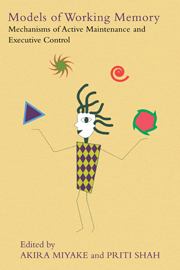Book contents
- Frontmatter
- Contents
- List of Contributors
- Dedication
- Preface
- Ode on Working Memory
- Acknowledgments
- 1 Models of Working Memory: An Introduction
- 2 Working Memory: The Multiple-Component Model
- 3 An Embedded-Processes Model of Working Memory
- 4 Individual Differences in Working Memory Capacity and What They Tell Us About Controlled Attention, General Fluid Intelligence, and Functions of the Prefrontal Cortex
- 5 Modeling Working Memory in a Unified Architecture: An ACT-R Perspective
- 6 Insights into Working Memory from the Perspective of the EPIC Architecture for Modeling Skilled Perceptual-Motor and Cognitive Human Performance
- 7 The Soar Cognitive Architecture and Human Working Memory
- 8 Long-Term Working Memory as an Alternative to Capacity Models of Working Memory in Everyday Skilled Performance
- 9 Interacting Cognitive Subsystems: Modeling Working Memory Phenomena Within a Multiprocessor Architecture
- 10 Working Memory in a Multilevel Hybrid Connectionist Control Architecture (CAP2)
- 11 A Biologically Based Computational Model of Working Memory
- 12 Models of Working Memory: Eight Questions and Some General Issues
- 13 Toward Unified Theories of Working Memory: Emerging General Consensus, Unresolved Theoretical Issues, and Future Research Directions
- Name Index
- Subject Index
7 - The Soar Cognitive Architecture and Human Working Memory
Published online by Cambridge University Press: 05 June 2012
- Frontmatter
- Contents
- List of Contributors
- Dedication
- Preface
- Ode on Working Memory
- Acknowledgments
- 1 Models of Working Memory: An Introduction
- 2 Working Memory: The Multiple-Component Model
- 3 An Embedded-Processes Model of Working Memory
- 4 Individual Differences in Working Memory Capacity and What They Tell Us About Controlled Attention, General Fluid Intelligence, and Functions of the Prefrontal Cortex
- 5 Modeling Working Memory in a Unified Architecture: An ACT-R Perspective
- 6 Insights into Working Memory from the Perspective of the EPIC Architecture for Modeling Skilled Perceptual-Motor and Cognitive Human Performance
- 7 The Soar Cognitive Architecture and Human Working Memory
- 8 Long-Term Working Memory as an Alternative to Capacity Models of Working Memory in Everyday Skilled Performance
- 9 Interacting Cognitive Subsystems: Modeling Working Memory Phenomena Within a Multiprocessor Architecture
- 10 Working Memory in a Multilevel Hybrid Connectionist Control Architecture (CAP2)
- 11 A Biologically Based Computational Model of Working Memory
- 12 Models of Working Memory: Eight Questions and Some General Issues
- 13 Toward Unified Theories of Working Memory: Emerging General Consensus, Unresolved Theoretical Issues, and Future Research Directions
- Name Index
- Subject Index
Summary
FIVE CENTRAL FEATURES OF THE THEORY
From the viewpoint of the Soar cognitive architecture, the term working memory (WM) refers to the psychological mechanisms that maintain information retrieved or created during the performance of a task. The following are the five key points made in the chapter concerning Soar's treatment of human WM:
(1) Soar is not specifically a “model of WM,” but rather a cognitive architecture of broad scope, which focuses on the functional capabilities needed for a memory system to support performance in a range of cognitive tasks. The functions of working memory are distributed across multiple components of the architecture, including the longterm production memory.
(2) Even in a cognitive architecture with an unbounded dynamic memory, WM limitations can arise on functional grounds. Where such functional accounts exist, they take theoretical priority over capacity-based explanations of WM phenomena.
(3) Soar does not currently include any capacity limits on its dynamic memory (SDM), but is compatible with certain such limitations. In particular, a constraint that SDM can hold at most two items of the same “type” (suitably defined) yields a coherent explanation for many psycholinguistic phenomena in the comprehension of sentences. This constraint is motivated by computational efficiency concerns and embodies the general principle of similarity-based interference (Baddeley & Logie, Chapter 2; Cowan, Chapter 3; Schneider, Chapter 10; and O'Reilly, Braver, & Cohen, Chapter 11, all in this volume).
[…]
- Type
- Chapter
- Information
- Models of Working MemoryMechanisms of Active Maintenance and Executive Control, pp. 224 - 256Publisher: Cambridge University PressPrint publication year: 1999
- 24
- Cited by

